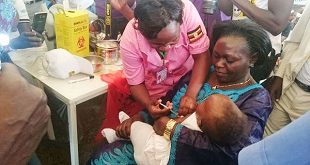
New study has lots of implications for authorities pondering decisions such as reopening schools
| THE INDEPENDENT | Research on COVID-19 pediatric patients is still limited, but a new study offers a fresh perspective on the early diagnosis and epidemic control of COVID-19 in children and could enhance early intervention and diagnosis.
Children were more likely to have fever, vomiting, and diarrhea.
However, their symptoms were usually less severe and didn’t last as long as adults with COVID-19.
A new study by Chinese researchers found that COVID-19 pediatric patients had higher incidents of initial symptoms like fever, vomiting, and diarrhea than adult patients and often recovered an average of 3 to 4 days after treatment.
The study was published on June 16 in the open access journal PLOS Medicine.
Research on COVID-19 pediatric cases is still limited, but this new study offers a fresh perspective on the early diagnosis and epidemic control of COVID-19 in children and could enhance early intervention and diagnosis.
Researchers sought to address the pediatric knowledge gap in an effort to provide insight into the early diagnosis and assessment of COVID-19 in children.
What the study found
The team of researchers, led by Xihui Zhou from the First Affiliated Hospital of Xi’an Jiaotong University in China, analyzed clinical data from 34 COVID-19 patients between Jan. 27 and Feb. 23.
They ranged in age from 1 month to 12 years old, and were from four hospitals in China.
Clinical and epidemiological characteristics were analyzed on the basis of demographic data, medical history, laboratory tests, radiological findings, and treatment information.
Out of the patients studied, 14 were male and 20 were female. In all, 18% of the patients had mild forms of COVID-19 while 82 percent had moderate forms.
In contrast to adult patients, fever and cough were the most common initial symptoms and patients typically recovered within 3 to 4 days after treatment.
Ground glass opacity — which is an area of increased haziness in the lungs through which vessels might still be seen — is common in adults. But these opacities were rare in pediatric cases.
Additionally, the patients were often hospitalized for a relatively short period of time. They were all discharged and the median hospital stay was 10 days.
Are children a risk to adults?
Researchers found no direct evidence regarding transmission from children to adults. But they warned that policymakers should consider the risk of family cluster transmission from children carrying the virus in making decisions about epidemic control.
“This is the first piece of data that clearly shows the high incidence of atypical COVID-19 cases in children,” said Dr. Dimitar Marinov, an assistant professor in the department of hygiene and epidemiology at Medical University in Varna, Bulgaria, whose research work includes the control and prevention of infectious diseases and who has followed COVID-19 trends closely.
“The most common symptom is still fever, like in adults, but the incidents of productive cough, vomiting, and diarrhea are much higher than in adults,” he said. “The cough in adults is typically dry and there is rarely any vomiting.”
He said the study once again demonstrates the unpredictability of the disease.
The new study highlights the fact that so much about the pathogen underlying the disease remains unknown and there’s so much more to learn, added Dr. Teena Chopra, a professor of infectious diseases at Wayne State University’s School of Medicine in Detroit.
“(What) is interesting is that the children [in the study] did not present with severe disease unlike adults,” she said. “And most of them had mild or moderate symptoms.”
Dr. Mobeen Rathore, a professor and associate chair of pediatrics at the University of Florida College of Medicine in Jacksonville, said that while the study isn’t groundbreaking, it does add to the body of knowledge.
“There is a limited understanding of what we know about COVID-19 in children,” said Rathore, a district vice chair for the American Academy of Pediatrics.
“We need to pay more attention to the kids. A lot of times people assume kids can’t get infected. I think children obviously can spread it to others. The symptoms may be milder, but they can certainly spread it to others,” he added.
The study has limitations, however. For one thing, said Chopra, it’s a retrospective study, which has some weaknesses inherent in its design.
“With retrospective studies there’s a lot of bias,” she said. “You can’t randomize, make changes, or order labs on patients that answer questions. You have the data already and you have to work with that data. Until the data is coupled with molecular data and you do whole genome sequencing, it is very difficult to draw conclusions. That could give us a lot of information.”
“It seems that in children there is a different manifestation of the virus,” she added. “The report highlights the fact that children can be affected by the virus.”
Marinov added that the low number of participants is a significant limitation and that larger samples are needed to confirm these findings.
Still, Chopra added that the study has lots of implications for authorities pondering decisions such as school reopenings in the fall.
Although the sample size is a “small number, it gives us insight into the world of children and helps us understand the impact on a younger age group,” said Chopra who serves on Wayne State’s reopening task force as well as one of a Detroit area school.
School officials “should take studies like this into account before opening schools and making decisions about whether it can affect children or not,” she said.
READ LATEST UGANDA UPDATES ON COVID-19 HERE (click)
****
Source: healthline
 The Independent Uganda: You get the Truth we Pay the Price
The Independent Uganda: You get the Truth we Pay the Price


